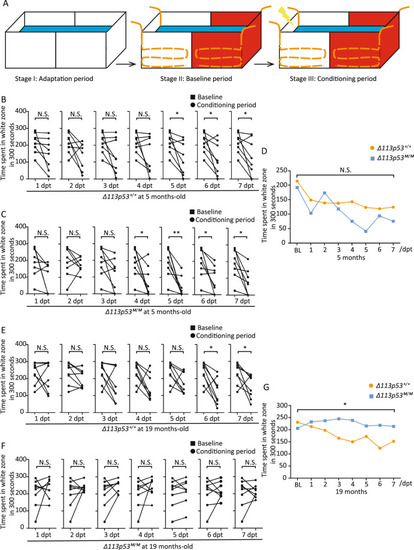|
Loss-of-function of <italic>Δ113p53</italic> impairs learning and memory capacity with aging.A The schematic of the CPA paradigm. Stage I: Adaptation period in the tank covered with white color (5 min/day for 3 days); Stage II: Baseline period in the test tank covered by one side with red color and the other with white color (5 min/day for 6 days without electric shock); Stage III: Conditioning period in the test tank (5 min/day for 7 days after electric shock from white color). In stage II, zebrafish behavior was recorded for the Baseline period. In stage III, a mild electric shock for one min (twice/day in 1-h interval) was delivered each time the fish entered the white zone. Zebrafish behavior was recorded 1 day after the treatment for the conditioning period. After recording, the fish was treated again and the assay was repeated for 7 days. B–G Statistical analysis of CPA assays on Δ113p53+/+ and Δ113p53M/M zebrafish at 5- or 19-months old. The paired t test was applied for the comparison of the time spent in the white color out of 300 s (=5 min) recorded between baseline and conditional periods within the same genotype either Δ113p53+/+ (B, E) or Δ113p53M/M (C, F). Each dot represents the time for individual fish spending in the white zone. Two-way ANOVA analysis was performed to analyze the differences of the average time spent in the white color at each time point between two genotypes of Δ113p53+/+ and Δ113p53M/M at 5- (D) or 19- (G) months old. BL Baseline period. In each group, eight zebrafish were used. Within-group comparison: paired t test. Between-group comparison: two-way ANOVA test. The P values were represented by N.S. and asterisks. N.S., P > 0.05, *P < 0.05, **P < 0.01.
|

